This post originally appeared on Murder Is Everywhere.
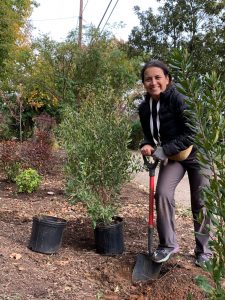
For too long, I’ve been lost in the LED-lit, indoor world of writing. Over the last month, I was intent on doing nothing else except finish a book.
It also happened that late November turned out to be the only time to plant a garden. Fall planting is easier on trees and shrubs that will get a good watering all fall and winter. Yes, I had a book due; but the garden also had to be installed, after having been delayed by several months due to Maryland’s unusually dry fall.
The garden and I have been at loggerheads before. My quest to unsettle a little less than an acre of city land began when I moved in with my family during the fall of 2012. The first thing we did was absolutely violent. We hired a company to drill four wells 500 feet deep inside our long, sloping lawn. The racket it made! The ash that spewed into the neighborhood air! The sky looked so gray over our street that somebody called the fire department.
Ah, the geothermal wells. They make it possible to have a modern air conditioning system where the air passes over the cold water, deep in the ground, and returns to the house. No chemicals, no excessive use of electricity.
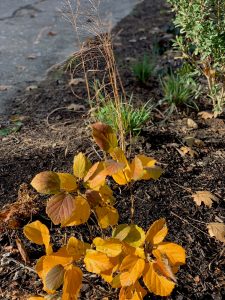
From almost the start, our land has served us. But it has always been scraggly around the edges. Every spring I would be filled with inspiration that would trickle away about the time the mosquitoes settled in for feasting at the end of June. I wanted a garden full of native plants to support wildlife and suppress weeds. But how? The longer I fretted, the more the weeds spread.
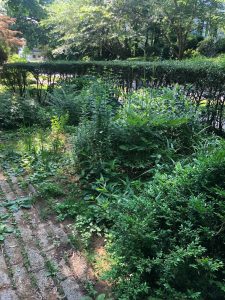
Three years ago, I dug a small front garden myself with native plants, but it was such a hodgepodge without coherent flow that I wanted more assistance the next time I tried an improvement. This fall, I felt blessed to be aided by a native gardening education consultant/garden artist/all-around genius. Kay McConnell is well known in Maryland for the beautiful native plant gardens she designed and installed at the Friends School of Baltimore, Stony Run Meeting, and other spots.
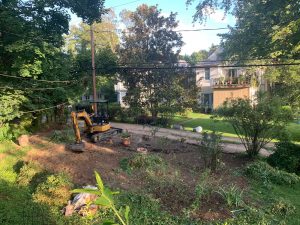
Under Kay’s eagle eye, a weed-filled stretch running along the back of the property was cleared in late August as the site of our future rain garden. The clearing and regrading of the earths was done by strong men driving big machines. The new space they created wasn’t flat smooth dirt, but two raised banks surrounding a long basin. This would catch water that ran down our sloping lawn toward the lane. The saved water would feed the kind of plants like native iris and milkweed that like their feet wet.
As the dry fall turned into a rainy November, the prepared, empty garden space slowly became wet. Kay rooted through her native plant stock and area nurseries, looking for the best shrubs, trees, grasses and native perennials. A willow, magnolias and dogwoods were found, along with itea, bayberry, buttonbush, various ferns, swamp milkweed, oak leaf hydrangea…
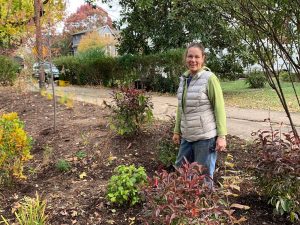
The list went on. Over several days in late November, Kay unloaded shrubs and flowering plants and grasses from her car. The trees came in with European Landscapes and Design, the company that had done the original garden clean-up and preparation.
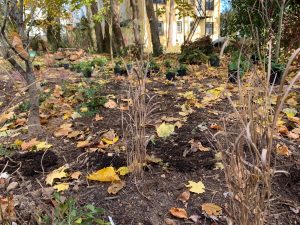
I recently heard a few different people use the phrase: “We go big, or we go home.” It’s a 2019 cliché. However, I could not deny that things were getting very big, right at my home.
I was thrilled to realize that every single tree, grass and shrub would feed local birds and insects. The garden design has woodland, meadow and swamp sections, with everything flowing together in an artistic manner, with fields of color, and high and low points. I found myself spellbound watching Kay. She is a true artist in the garden, arranging plants and rearranging them as the visual flow becomes apparent to her.
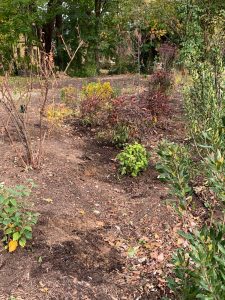
As I worked under Kay’s direction, I learned so much. She taught me how to plant a natural looking drift of small flowers. I absorbed the new thinking on weed control: don’t tug them out, which disrupts the earth and activates weed seeds. Instead, cut them close to the ground to weaken the plant.
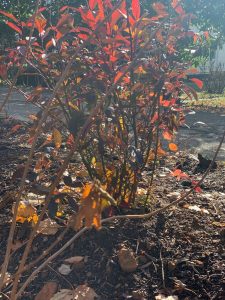
I saw, through her eyes, how an aged stretch of asphalt pavers could become a dining terrace or site for a fire-pit gathering spot. And as my neighbors strolled along the lane that runs on the other side of the new garden, they had plenty to say. Michael, after visiting with us a few times, commented that he felt that spirits had entered the garden that were never there before.
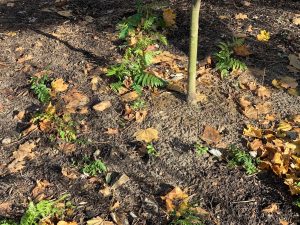
And that’s how writing works, too. A bulky stone is chipped away to reveal the story hiding within. It takes time, but it’s always waiting for you.
And the thing about gardening deadlines is that the only one that really matters is set by nature. One can’t dig after the ground is frozen—unless, perhaps, you have a geothermal drill.
And putting a plant into earth does not guarantee it will emerge in the spring. That is the mystery I’m entering.
